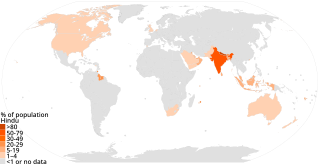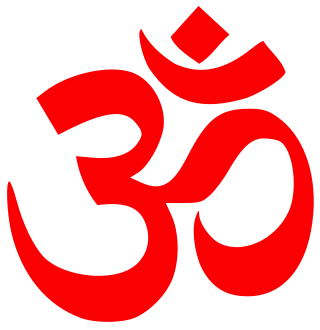
Hinduism is a minority religion in South America, which is followed by even less than 1% of the total continent's population. Hinduism is found in several countries, but is strongest in the Indo-Caribbean populations of Guyana and Suriname. There are about 320,000 Hindus in South America, chiefly the descendants of Indian indentured laborers in the Guianas. There are about 185,000 Hindus in Guyana, 120,000 in Suriname, and some others in French Guiana. In Guyana and Suriname, Hindus form the second largest religion and in some regions and districts, Hindus form the majority. Though in recent times, due to influence of Hindu culture the number of Hindus converts have increased in other countries in South America, including Brazil, Argentina, Venezuela and others.

According to the Book of Idols by the medieval Arab scholar Hisham ibn al-Kalbi, Hinduism was present in pre-Islamic Arabia. Ibn Al-Kalbi explains the origins of idol worshipping and the practice of circumambulation as rooted in India and Hinduism.

Indo-Trinidadians and Tobagonians or Indian-Trinidadians and Tobagonians are people of Indian origin who are nationals of Trinidad and Tobago, whose ancestors came from India and the wider subcontinent beginning in 1845 during the period of colonization.

Hinduism has approximately 1.2 billion adherents worldwide. Hinduism is the third largest religion in the world behind Christianity (31.5%) and Islam (23.3%).

Hinduism is the leading single religion of the Indo-Caribbean communities of the West Indies. Hindus are particularly well represented in Guyana, Suriname and Trinidad and Tobago. The Cayman Islands also hosts a sizable Hindu population, with 2.4 percent of the country affiliating with the religion. Smaller groups of Indo-Caribbeans live elsewhere in the Caribbean, especially Puerto Rico, Jamaica, Belize, Barbados, Saint Vincent and the Grenadines, Saint Lucia, and Bahamas.

Hinduism in Trinidad and Tobago is the second largest religion. Hindu culture arrived to Trinidad and Tobago in 1845, with the arrival of the first Indian indentured laborers, the overwhelming majority of which were Hindu. According to the 2011 census there were 240,100 declared Hindus in Trinidad and Tobago.
Religion in Trinidad and Tobago, which is a multi-religious country, is classifiable as follows:

Hinduism is the third-largest religious group in the United Kingdom, after Christianity and Islam; the religion is followed by over one million people representing around 1.6% of the total population. According to the 2021 United Kingdom census Hindus are primarily concentrated in England, particularly in Greater London and the South East, with just under 50,000 Hindus residing in the three other nations of the United Kingdom. Hindus have had a presence in the United Kingdom since the early 19th century, as at the time India was part of the British Empire. Many Indians in the British Indian Army settled in the United Kingdom of Great Britain and Northern Ireland.

Hinduism is the third largest religious group in the Netherlands, after Christianity and Islam; representing about 1.0% of the Dutch population in 2019. After the United Kingdom and Italy, the third largest Hindu community of Europe lives in the Netherlands. There are between 150,000 – 200,000 Hindus currently living in the Netherlands, the vast majority of who migrated from Suriname – a former Dutch colony in South America. There are also sizable populations of Hindu immigrants from India, Sri Lanka, Nepal, and Afghanistan, as well as a smaller number of Western adherents of Hinduism-oriented new religious movements.

Hinduism in Azerbaijan has been tied to cultural diffusion on the Silk Road. One of the remnants of once-dominant Hindu and Buddhist culture in the Caucasus is Surakhani, the site of the Ateshgah of Baku. As of 2020, there were about 500 Hindus in Azerbaijan.

Hinduism is a minority religion in Belgium. According to the PEW 2014, Hinduism is also the fastest growing religion in Belgium. Attempts have been done by the Hindu Forum of Belgium (HFB) to make Hinduism an officially-recognized religion in Belgium.

Hinduism was first introduced by Sindhi settlers who migrated to Ghana after India was divided in 1947. It was spread to Ghana actively by Ghana's Hindu Monastery headed by Swami Ghananand Saraswati and by the International Society for Krishna Consciousness (ISKCON). Hinduism is one of the fastest growing religions in Ghana.

Hinduism is a minority faith in Zimbabwe.

Hinduism is a minority religion in Sweden practised by 0.13% of the population or 13,000 people out of a population of 10.5 million. Hinduism is practised mainly by persons of Indian origin and non-resident Indians together. A majority of them are Tamils, Punjabis, Bengalis, Gujaratis, Telugu's and Kannadigas.

Hinduism is a minority religion in Scotland. A significant number of Hindus settled there in the second half of the 20th century. At the time of the 2001 UK Census, 5,600 people identified as Hindu, which equated to 0.1% of the Scottish population and was slightly above the number of Hindus in Wales. In the 2011 Census, the number of Hindus in Scotland almost tripled to over 16,000 adherents. In the 2022 census, this number nearly doubled to just under 30,000 Hindus, representing about 0.6% of the population in Scotland.

Hinduism in England is the third largest religion in the country, with over 1,020,533 followers as of the 2021 census. This represents over 1.8% of the English population, up from 1.5% in 2011 and 1.1% in 2001. Hindus are predominantly in the cities of London and Leicester, where they make up greater proportions of the population. England has a number of Hindu temples, including the Hindu temple at Neasden which is a large Hindu temple in Europe. In 2007, the largest Hindu Mandir in the North of England, the Bradford Lakshmi Narayan Hindu Temple opened in Bradford, West Yorkshire.
In religion and spirituality, a pilgrimage is a very long journey or search of great moral significance. Sometimes, it is a journey to a sacred area or shrine of importance to innate faith. Members of every major religion participate in pilgrimages. A person who makes such a journey is called a pilgrim.

Hinduism in Suriname is the second-largest religion. According to ARDA, there are 129,440 Hindus in Suriname as of 2015, constituting 23.15% of the population. Suriname has the second largest percentage of Hindus in the Western Hemisphere, after Guyana (24.8%).

Hinduism in Guyana is the religion of about 31% of the population in 2020. This makes Guyana the country with the highest percentage of Hindu residents in the Western Hemisphere.
Caribbean Shaktism, also known as Kalimai Dharma or Madras Religion in Guyana, refers to the syncretic Shakti Kali/Mariamman worship that has evolved within the Indo-Caribbean Tamil community in countries such as Guyana, Trinidad and Tobago, Guadeloupe, Martinique, Jamaica and Suriname. It can be found across the Caribbean and any South American country with an Indo-Caribbean community. It is a syncretic blend of Dravidian folk religion and Hinduism and has also been influenced by other cultural and religious traditions found in the Caribbean such as Catholicism, Trinidad Orisha, Comfa and Obeah. It is considered to be a form of Folk Tamil Hinduism and many attend services of Vedic Origin, more Orthodox Tamil Origin, and Madrasi origin.








